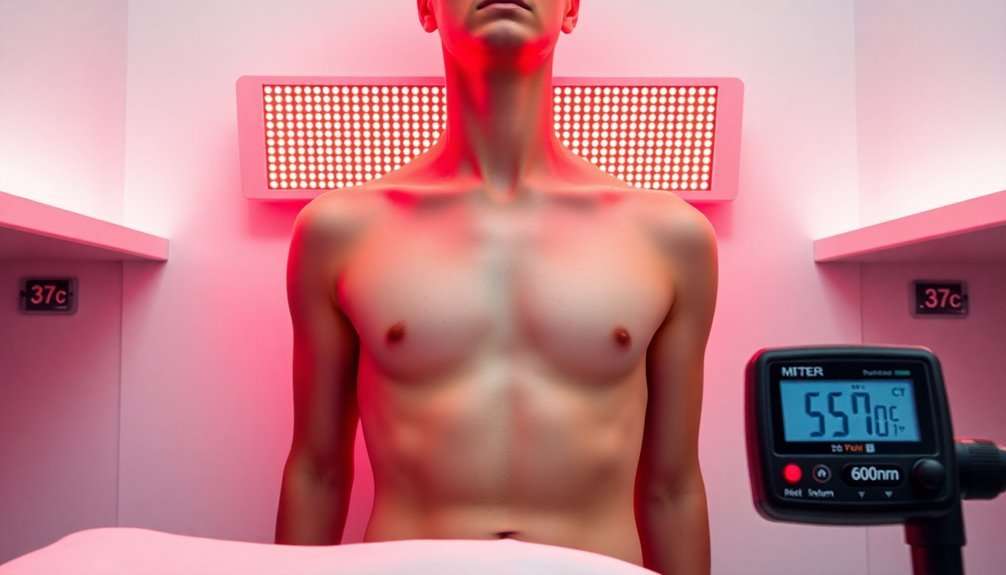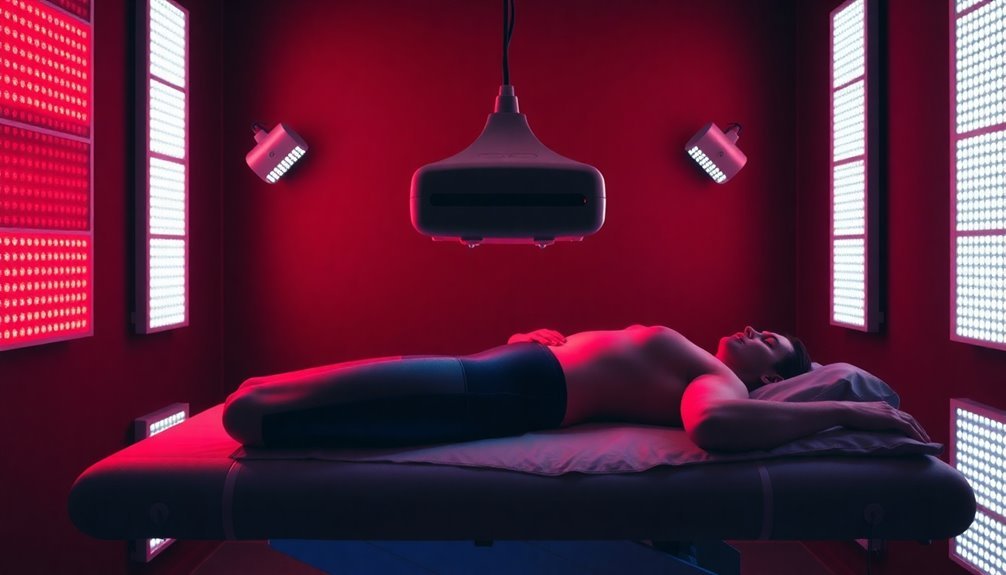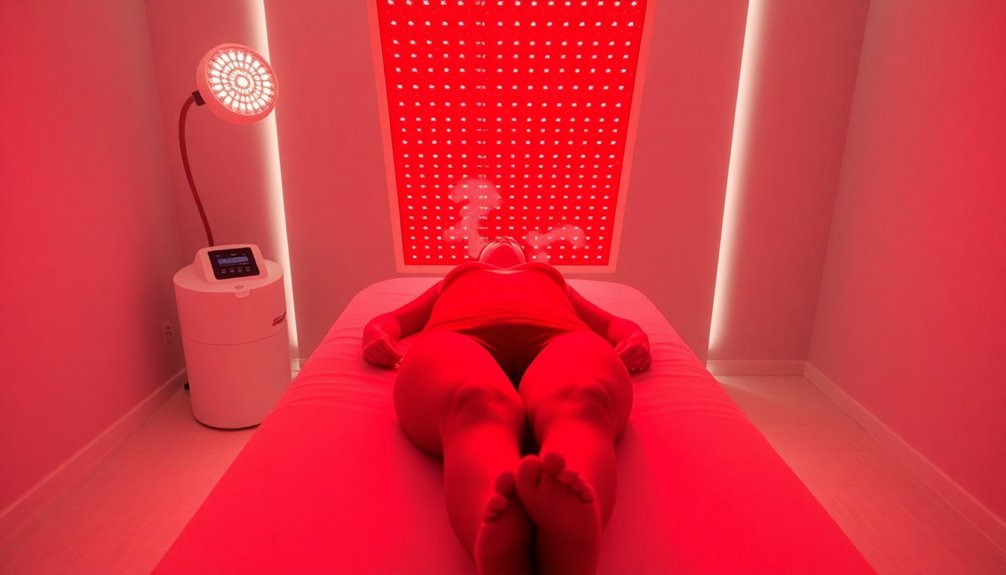You'll boost your metabolism up to 50% faster with these three proven photobiomodulation methods. Start with Red-NIR Dual Wavelength Therapy, which activates cellular energy production through precise 620-825nm light waves. Next, try Transcranial Light Treatment to enhance your brain's metabolic processes and ATP production using 810nm or 1064nm wavelengths. Finally, implement Targeted Muscle Recovery Sessions with 660-850nm light to accelerate muscle repair and increase oxygen consumption. These science-backed approaches work by stimulating your mitochondria and improving your body's natural energy systems. Discover how these powerful techniques can transform your metabolic health.
Red-NIR Dual Wavelength Therapy

Red-NIR light therapy's dual-wavelength approach targets cellular metabolism at its core by enhancing the activity of cytochrome c-oxidase (CCO), a pivotal enzyme in ATP production. By utilizing wavelengths between 620-680 nm (red) and 760-825 nm (near-infrared), you'll activate CCO's spectral absorption peaks, boosting your cellular energy production.
When you undergo this therapy, it'll enhance your aerobic cellular respiration by improving cytochrome C's electron transfer capabilities. Typical therapy sessions lasting 10-20 minutes daily provide optimal benefits for metabolic enhancement. You'll experience increased oxidative metabolism and reduced glucose levels as your mitochondria become more efficient.
The therapy also reduces nitric oxide binding, which means more oxygen becomes available for energy production.
You'll find this therapy particularly effective for weight loss when combined with exercise and proper diet. It helps release fatty acids from your fat cells into your bloodstream, where they can be burned for energy. However, you'll need to maintain a calorie deficit to guarantee these released fats don't get stored elsewhere.
To maximize results, you should focus on maintaining good blood flow to targeted areas and pair the therapy with appropriate physical activity.
Transcranial Light Treatment
Through targeted light exposure to your brain, transcranial photobiomodulation (PBM) activates key metabolic processes that enhance neural function and energy production. When specific wavelengths of light reach your brain tissue, they activate cytochrome c oxidase, boosting ATP production and improving mitochondrial function in your neurons. Modern research shows STAT3 and ERK signaling significantly increases in the cerebral cortex during treatment.
You'll experience increased cerebral blood flow as the treatment triggers nitric oxide release and vasodilation. This enhanced circulation, combined with improved cellular energy metabolism, supports better cognitive function and neuroprotection.
The treatment's effectiveness comes from using precise wavelengths, typically 810 nm or 1064 nm, which can penetrate your skull effectively.
Whether you're looking to prevent cognitive decline or enhance brain function, transcranial PBM offers measurable benefits. It's particularly effective for aging brains, helping maintain metabolic activity and promoting cell survival.
The treatment can reduce neuroinflammation and support neuroregeneration through multiple sessions. Remember that dosing is essential – you'll need the right combination of wavelength, fluence, and treatment duration for ideal results, as excessive exposure may diminish the benefits due to the treatment's hormetic nature.
Targeted Muscle Recovery Sessions

During intensive training sessions, targeted muscle recovery with photobiomodulation offers significant benefits for your muscular health and performance. You'll experience reduced muscle damage, decreased inflammation, and faster recovery times when you apply red or near-infrared light at wavelengths between 660-850nm.
This treatment works best when you target multiple points along your muscle fibers, using either LED or laser devices with power outputs between 10-30mW. Studies show that this approach delivers maximum voluntary contraction in treated muscles.
For ideal results, you'll want to implement PBM both before and after your workouts. Pre-exercise application enhances oxygen consumption and delays muscle fatigue, while post-exercise treatment accelerates recovery and reduces inflammatory markers like creatine kinase.
- Position the light device directly on your target muscle group, moving systematically across 5 different spots for 30 seconds to 2.5 minutes each.
- Apply the treatment in a grid pattern, following your muscle fiber orientation for maximum tissue penetration.
- Focus extra attention on areas experiencing the most strain, ensuring complete coverage of the affected muscle groups.
The key is consistency in your application while maintaining proper dosage levels around 600J total for larger muscle groups.
Frequently Asked Questions
Can Photobiomodulation Help With Seasonal Affective Disorder and Metabolism Changes?
Yes, photobiomodulation can help you manage SAD by boosting your mood and metabolism. It'll enhance your mitochondrial function, increase ATP production, and improve brain function through better blood flow and oxygenation.
How Long Should You Wait Between Eating and Photobiomodulation Sessions?
While there's no strict rule, you'll want to wait 1-2 hours after eating before your photobiomodulation session. This allows your digestive system to settle and may help optimize your body's response to treatment.
Does Skin Color or Thickness Affect Photobiomodulation Treatment Effectiveness?
Yes, both skin color and thickness affect your treatment's effectiveness. If you have darker or thicker skin, you'll need higher doses or longer sessions, and near-infrared light may work better for deeper penetration.
Can Photobiomodulation Interfere With Prescription Medications That Affect Metabolism?
Yes, you'll need to be careful as photobiomodulation can interact with metabolic medications by altering glucose metabolism and insulin sensitivity. Consult your healthcare provider before combining PBM with any prescription medications.
What Clothing Materials Block or Enhance Photobiomodulation Therapy Effects?
You'll want to avoid thick, dark fabrics and multiple layers as they block light. Instead, wear thin, light-colored, breathable materials like cotton or specialized therapy garments to enhance photobiomodulation's effectiveness during treatment.
In Summary
You'll find these three photobiomodulation methods can revolutionize your metabolic health when used consistently. Whether you're using red-NIR therapy for full-body wellness, transcranial treatments for enhanced brain function, or targeted sessions for muscle recovery, you're tapping into proven ways to boost your metabolism. Start with one method that fits your needs best, and you'll likely notice positive changes within weeks.





Leave a Reply